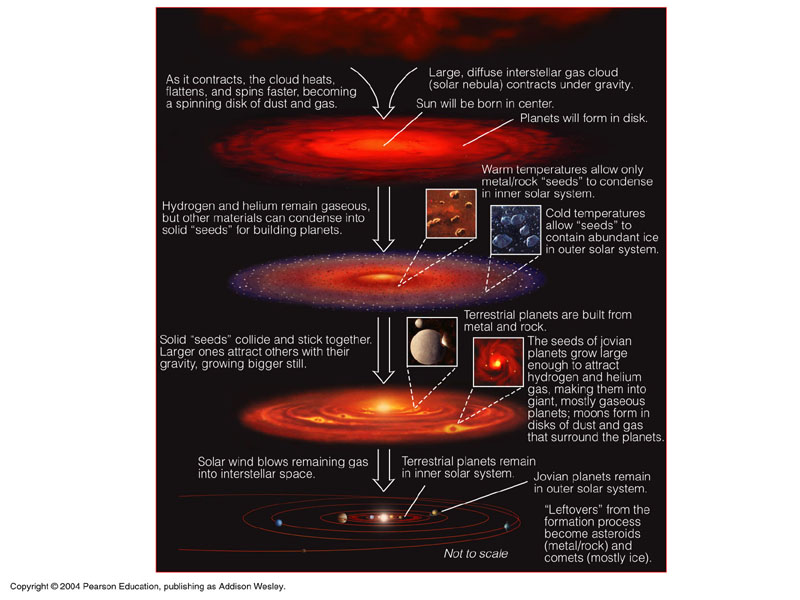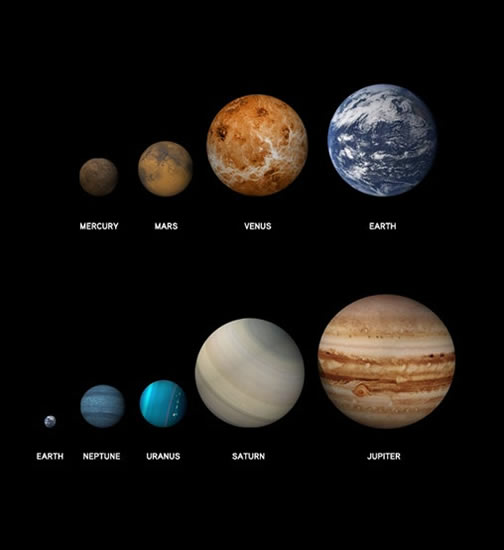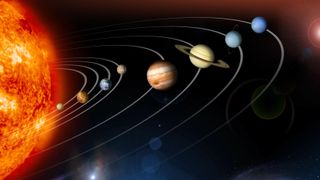As we have seen the comets asteroids and meteorites are surviving remnants from the processes that formed the solar system. They believe that this dust and gas began to collapse under the weight of its own gravity.

Solar System Astronomy Lecture Number 11
The Sun ejected rocky material which later went on to form the planets.

. Which term best describes how the solar system formed. The students tie a tennis ball to a string. All of us believe that the Solar System evolved from a giant cloud of dust and gas.
When this dust cloud collapsed it formed a solar nebula a spinning swirling disk of material. The solar nebular hypothesis describes the formation of our solar system from a nebula cloud made from a collection of dust and gas. A viable theory of solar system formation must take into account motion constraints chemical constraints and age constraints.
The widely accepted theory about the formation of the solar system is the Nebular Hypothesis which states that it was formed by the gravitational collapse of. This nebula was the result of the collapse of an interstellar cloud of gas and dust which contracted. Gravity caused the protoplanetary disk to rotate and form a solar nebula which became the sun.
The string passes through a spool and is attached to a 1 kilogram mass. Several stars of different masses cooled and formed the planets and the Sun. 45 billion years 2.
In essence this theory states that the. Option d rapidly term best describes how the solar system formed. One very large planetary body broke apart into several smaller planets.
What force pulled the solar system together out of a cloud of gas and dust. Which of the following is a terrestrial planet. Our solar system began forming about 46 billion years ago within a concentration of interstellar dust and hydrogen gas called a molecular cloud.
Gravity caused small particles to collide to form larger particles called planetesimals which eventually formed the sun. Which term best describes how the solar system formed. Where can you find the asteroid belt.
The cloud was about 20 parsec 65 light years across while the fragments were roughly 1 parsec three and a quarter light-years across. Which term best describes how the solar system formed. 450 million years d.
They believe that this dust and gas began to collapse under the weight of its own gravity. Which term best describes how the. When it comes to the formation of our Solar System the most widely accepted view is known as the Nebular Hypothesis.
The mass pulls down on the string as the students spin the tennis ball around the spool. The cloud collapsed possibly due to the shockwave of a nearby exploding star called a supernova. 45 million years c.
What angle is formed by the sun the earth and the moon during an eclipse. Which figure is closest to the age of the solar system. Which of the following is a terrestrial planet.
What force pulled the solar system together out of a cloud of gas and dust. The nebular hypothesis says that the Solar System formed from the gravitational collapse of a fragment of a giant molecular cloud. Meteorites comets and asteroids are survivors of the solar nebula out of which the solar system formed.
What does this tell us about the average star formation event in. Describe the main events of the further evolution of the solar system. Gravity collapsed the material in.
Mitgliedd1 and 2 more users found this answer helpful. Between Mars and Jupiter. Arotating disk of gas and dust was drawn together by the force of gravity.
Solar System Quiz 1. The strong force b. Students are making a model of planetary motion.
A ElectricallyB GraduallyC ChemicallyD Rapidly Get the answers you. Approximately 46 billion years ago the solar system was a cloud of dust and gas known as a solar nebula. All of us believe that the Solar System evolved from a giant cloud of dust and gas.
It is believed that the sun planets moons and asteroids were. Gravity caused the solar nebula to collapse toward the center causing the center to be dense and hot. The remainder of the cloud formed a swirling disk called the solar nebula.
Our solar system formed about 45 billion years ago from a dense cloud of interstellar gas and dust. The cloud contracted under its own gravity and our proto-Sun formed in the hot dense center. As it did so the matter contained within this could begin moving in a giant circle much like the water in a drain moves around the center of the drain in a circle.
The planets moons and the Sun of course also are the products of the formation process although the material in them has undergone a wide range.

How Our Solar System Formed Article Khan Academy


0 Comments